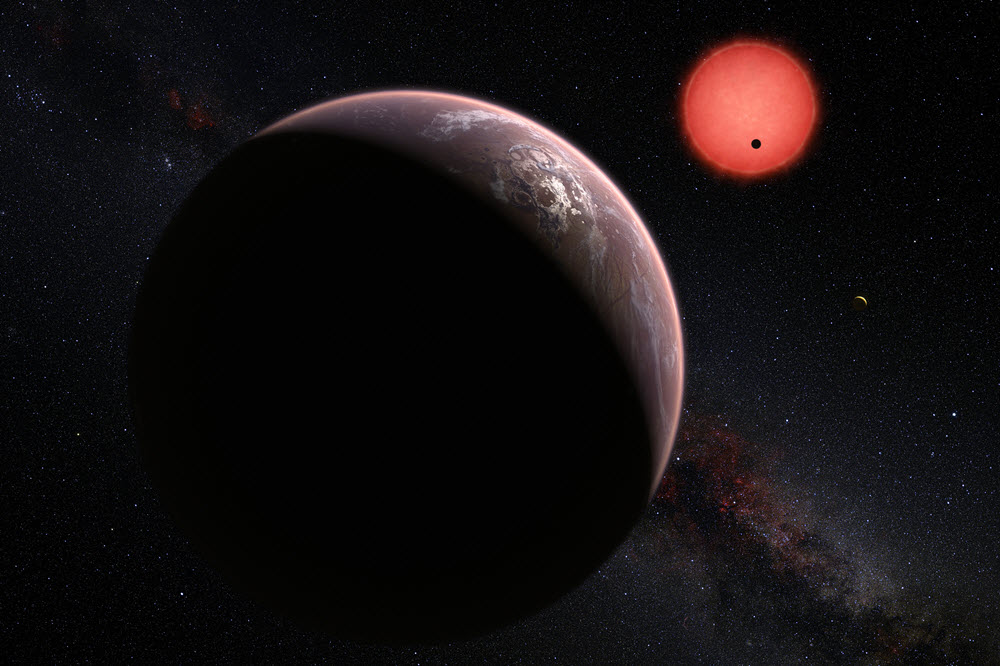Astronomers discover potentially habitable planets just 40 light years from Earth
May 3, 2016

This artist’s rendering shows an imagined view of the three planets orbiting an ultracool dwarf star just 40 light-years from Earth that were discovered using the TRAPPIST telescope at ESO’s La Silla Observatory. In this view, one of the inner planets is seen in transit (black dot) across the disc of its tiny and dim parent star. (credit: M. Kornmesser/ESO)
Astronomers have detected three exoplanets just 40 light years from Earth whose sizes and temperatures are comparable to those of Earth. The planets may be the best targets found so far for the search for life outside the solar system.
The results were published Monday (May 2) in the journal Nature.
Because the system is relatively close to Earth, co-author Julien de Wit, a postdoc at MIT, says scientists will soon be able to study the planets’ atmospheric compositions, as well as assess their habitability and whether life actually exists within this planetary system.
The scientists discovered the planets using TRAPPIST (TRAnsiting Planets and PlanetesImals Small Telescope), a 60-centimeter telescope operated by the University of Liège, based in Chile. Built by lead authors Michael Gillon and Emmanuel Jehin of the University of Liège, TRAPPIST is designed to focus on 60 nearby small, “ultracool” dwarf stars (those with effective temperatures of less than 2,700 kelvin) — stars that are so faint they are invisible to optical telescopes and are monitored at infrared wavelengths.
The team focused the telescope on the dwarf star, which they named TRAPPIST-1 — a Jupiter-sized star that is one-eighth the size of our sun and significantly cooler. Over several months, the scientists observed the star’s infrared signal fade slightly at regular intervals, suggesting that several objects were passing in front of the star.
Most exoplanetary missions have been focused on finding systems around bright, solar-like stars. These stars emit radiation in the visible band and can be seen with optical telescopes. However, because these stars are so bright, their light can overpower any signal coming from a planet. Ultracool stars emit radiation in the infrared band. Because they are so faint, these tiny red stars would not drown out the image of a planet crossing the star, giving scientists a better chance of detecting orbiting planets.
May be in the habitable zone
From their observations, the scientists determined that all three planets are likely tidally locked, with permanent day and night sides.
The two innermost planets orbit the star in 1.5 and 2.4 days and receive only four and two times, respectively, the amount of radiation the Earth receives from the sun. The third planet may orbit the star in anywhere from four to 73 days, and may receive even less radiation than Earth. But given their size and proximity to their star, all three planets may have regions with temperatures well below 127 degrees C (260 degrees F), within a range that is suitable for sustaining liquid water and life.
The two planets closest to the star may have day sides that are too hot, and night sides too cold, to host any life forms. However, there may be a “sweet spot” — a region that still receives daylight, but with relatively cool temperatures — on the western side of both planets that may be temperate enough to sustain conditions suitable for life. The third planet, furthest from its star, may be entirely within the habitable zone.
“Now we have to investigate if they’re habitable,” de Wit says. “We will investigate what kind of atmosphere they have, and then will search for biomarkers and signs of life. We have facilities all over the globe and in space that are helping us, working from UV to radio, in all different wavelengths to tell us everything we want to know about this system.”
This research was funded, in part, by the Belgian Fund for Scientific Research, the European Research Council, and NASA.
Abstract of Temperate Earth-sized planets transiting a nearby ultracool dwarf star
Star-like objects with effective temperatures of less than 2,700 kelvin are referred to as ‘ultracool dwarfs’. This heterogeneous group includes stars of extremely low mass as well as brown dwarfs (substellar objects not massive enough to sustain hydrogen fusion), and represents about 15 per cent of the population of astronomical objects near the Sun. Core-accretion theory predicts that, given the small masses of these ultracool dwarfs, and the small sizes of their protoplanetary disks, there should be a large but hitherto undetected population of terrestrial planets orbiting them—ranging from metal-rich Mercury-sized planets to more hospitable volatile-rich Earth-sized planets. Here we report observations of three short-period Earth-sized planets transiting an ultracool dwarf star only 12 parsecs away. The inner two planets receive four times and two times the irradiation of Earth, respectively, placing them close to the inner edge of the habitable zone of the star. Our data suggest that 11 orbits remain possible for the third planet, the most likely resulting in irradiation significantly less than that received by Earth. The infrared brightness of the host star, combined with its Jupiter-like size, offers the possibility of thoroughly characterizing the components of this nearby planetary system.